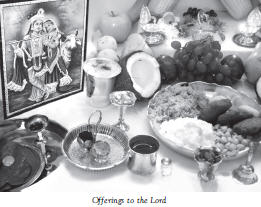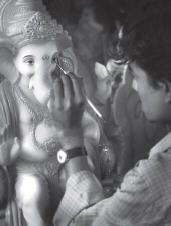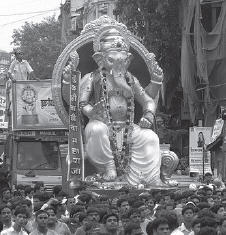A look at the modern trends shows that we have much
to gain by sticking to the traditional practices

Devotion, like love, is eternal a natural inclination to worship the Lord with deepest heartfelt offerings and with the sole motivation of pleasing Him. Along with our pure emotions we also present suitable articles: incense, lamp, scent, flowers, fans, and clothes etc., that the Lord likes. The Lord is a person like all of us, and has His tastes. By satisfying the transcendental senses of the Lord, by offering fitting gifts coupled with our love, we achieve supreme happiness, much more than what we can get by fulfilling our selfish desires.
Although the principles of Supreme Lord, devotee, and devotional service are eternal, the details of serving the Lord may vary according to time, place, and circumstances. For example when Narada Muni advised the child Dhruva about the practice of devotional service, he made some adjustments because Dhruva was located in a forest, where all the paraphernalia for elaborate Deity worship was impossible to obtain [Bhag 4.8.54]. Srila Prabhupada writes in the purport of this verse: “One has to consider the particular time, country and conveniences. What is convenient in India may not be convenient in the Western countries…it might be that there are changes in the manner of worship, but that is not at all faulty according to shastra.”
Still in the name of liberalism we cannot whimsically change the principles, a common occurrence that eventually drains the practice of its sanctity leaving behind just a body of ritual, much bedecked, but dead without any spirit. Such a ritual may appear like the original act of devotion, but with purity of the tradition missing, it simply boils down at best to another obligation that has to be fulfilled or at worse to a selfish perversion in the name of religion. The latter, unfortunately, is the trend that is gradually creeping into modern day Ganesha worship.
The Form of Ganesha
Tantrasara-sangrha, chapter 4, verse 91 mentions the form of Ganesha as:
mahodro gajamukhah pasadantakusabhye
bibhrayeyo vighnaharah kamdastvaraya hyayam
Translation: This Vighnesa is big-bellied, with the face of an elephant and holds in his hands a rope, a tooth, a hook, and abhaya mudra. One should contemplate that he removes all obstacles and speedily grants our desires, as supported by authorities.
It also says:
raktambaro raktatanu raktamalyanulepanah
Translation: Vignesa wears red garments, has a red body and wears red garlands with a body anointed with sandal and kumkuma. (Text 90)
These verses tell us about the form of Lord Ganesha and also the objects that he holds. The deity therefore should be made according to this direction. One should not reduce the sacred science of deity sculpting to a platform of expressing creativity and whimsically sculpt a form of Ganesha. Unfortunately nowadays we have people using the Ganesha festival as opportunities to depict Ganesha as some kind of comic book hero who can metamorphosise into a new avatara to cater to his devotees in modern times. So now we have Ganesha with a peacock feather, holding a flute, or a vina, or a cricket bat, or wicket-keeper’s gloves, or sitting in a yogic pose, posing like a popular god-man. Why speculate?
Substance of the form

In Shiva Purana Lord Shiva describes that the deity of Ganesha should be made of metal, coral, white arka flowers or clay. (Rudrasamhita, chapter 18, text 42-43) Lord Krishna also describes to Uddhava the substances that are used to make a Deity. “The Deity form of the Lord is said to appear in eight varieties stone, wood, metal, earth, paint, sand, the mind or jewels.” (Srimad Bhagvatam 11.12.27)
The traditional way of worshiping deities made of clay and painted with natural dyes perfectly harmonizes with modern day feeble ecological conditions; it is so eco-friendly. Clay dissolves quickly, a mere two or three dips of the deity are enough for melting down and submersion, and the colors are of vegetable origin and easily bio-degradable without any toxic residue. On the other hand, the statues that are made presently with Plaster of Paris(PoP) and painted with chemical dyes are ecological disasters. They take more than a month to melt in sweet, stationary waters. Often the cut parts of the deity float offshore to the horror of the worshiper. In Mumbai the giant PoP statues have to be cut into pieces by mechanized saws, right before the devotees, which is so distasteful. The need of the current century, therefore, is to shift to the age-old tradition.
Simplicity of tradition
Rudra samhita, Shiva Purana mentions about Ganesha worship as follows: “The Ganesha deity should be worshiped with all purity, with divine scents of various kinds, sandal paste, and flowers. After the first prahar of the night, one should take bath and worship with druva grass. Then worship with incense, lamps, different kinds of food-offerings, betel and eulogize with hymns and then worship the crescent moon.”
The mood is of devotion.
The current trend of Ganesha worship, however, is something like an all-night party. Loud film music, drinking, and gambling, and anti-social elements, especially during the submersion parade, play a major role. Now the trends are in favor of mega festivities sponsored by corporate giants with huge banners everywhere that are full of advertisements (often of derogatory products using garish images) but a small Ganesha depicted in a tiny corner. Devotion pales in an atmosphere surcharged with commercialism.
Offerings to Lord Ganesha

Lord Ganesha wrote Bhagavad-gita after fully understanding the meanings of the words of Srila Vyasadeva. There in chapter 3 text 13 Lord Krishna mentions that the devotees of the Lord accept food that is offered in the yajna or sacrifice. Food should be offered to Lord Krishna and then eaten by the devotees. Lord Ganesha is a natural devotee of Lord Krishna and he will be pleased to accept the maha-prasada of Lord Krishna and offer it his own devotees. The worshipers in Madhva-sampradaya who celebrate Ganesha festivals, therefore first make all the offerings to a Saligrama sila, which is Lord Krishna’s Deity form, and then offer the maha-prasada to Ganesha. The same practice can be followed by everyone.
In conclusion, we should try to keep the mood of sincere, selfless devotion while worshiping the Lord and see that the traditional practices are upheld and followed in true spirit. Earnest heart-felt dedication should take precedence over a gaudy show with commercial interest foraying in the back-ground. We should simply aspire for pure, unmotivated devotion to the Supreme Lord, and pray to Him to remove all obstacles in the path of our devotion and guide us to the ultimate shelter.
